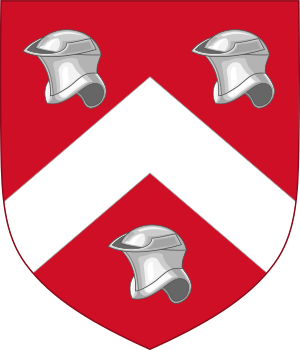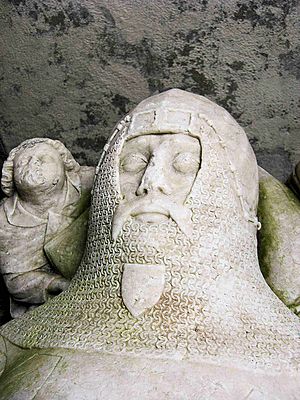Tudors of Penmynydd facts for kids
The Tudors of Penmynydd (Welsh: Tuduriaid Penmynydd) were a powerful family from Penmynydd village in Anglesey, North Wales. They played a big role in Welsh and later English politics. From this family came Owen Tudor, who was the ancestor of the famous Tudor dynasty. This dynasty ruled England from 1485 to 1603. The Tudor rule ended in the early 1600s with the death of Elizabeth I.
Contents
The Tudor Family's Beginnings
The Tudor family came from Ednyfed Fychan, a Welsh warrior who died in 1246. He was a chief advisor, called a seneschal, to Llywelyn the Great, a powerful prince in north Wales. Ednyfed Fychan was said to be a descendant of Marchudd ap Cynan, a lord and protector of Rhodri the Great. Rhodri was a king of Gwynedd and one of the "Fifteen Tribes of Wales."
Ednyfed Fychan had many sons. Some of them became important leaders in north Wales. He gave his lands in Anglesey, including Penmynydd, to the sons he had with his second wife, Gwenllian. One of these sons was Goronwy (died 1268). He is known as the founder of the Tudors of Penmynydd family line.
Goronwy also served as a seneschal for Llywelyn ap Gruffudd, the last Welsh king of Gwynedd. Goronwy's son, Tudur Hen (died 1311), later accepted the rule of Edward I of England. Tudur Hen also helped start a religious house in Bangor. His grandson, Tudur ap Goronwy (died around 1367), was also an important figure. This family held lands in Anglesey and other parts of Wales.
The Time of Owain Glyndŵr
Sir Tudur's sons were close to Richard II of England. These sons included Goronwy ap Tudur, Rhys ap Tudur, and Gwilym ap Tudur. However, when King Richard II was removed from power, Rhys, Gwilym, and their brother Maredudd ap Tudur joined a rebellion. They supported Owain Glyndŵr, a Welsh leader who wanted Wales to be independent. Owain Glyndŵr was a relative of one of their father's wives.
Rhys was executed in 1412. After Owain Glyndŵr's rebellion failed, the English king took most of the Tudor family's lands. These lands were then given to another branch of Ednyfed Fychan's family, the Griffiths of Penrhyn. The head of that family, Gwilym ap Griffith, had married Goronwy's daughter, Morfydd.
The Famous Tudor Dynasty
The Tudors of Penmynydd became very famous because of a younger son, Owain Tudur. He was the son of Maredudd ap Tudur, who had joined the rebellion. Owen Tudor became a courtier, someone who works at a royal court. He secretly married Catherine of Valois, who was the widowed queen of King Henry V.
Owen Tudor and Catherine had two sons: Edmund Tudor, 1st Earl of Richmond (died 1456) and Jasper Tudor, Duke of Bedford (died 1495). Edmund Tudor married Margaret Beaufort. She was from the House of Lancaster, another powerful English family.
Edmund and Margaret had one son, Henry Tudor, born on January 28, 1457. Henry was born after his father Edmund had died. Henry grew up in Wales and later lived in exile in France. Henry's mother, Margaret, made a plan with other powerful families to support her son. They wanted Henry to become king.
Henry Tudor landed in South Wales with his supporters. He gathered more troops and defeated King Richard III at the Battle of Bosworth on August 22, 1485. After the battle, Henry declared himself King Henry VII of England.
King Henry VII married Elizabeth of York. She was the daughter of King Edward IV and the main heir of the House of York. This marriage helped bring peace between the warring families of Lancaster and York. Henry and Elizabeth had a happy marriage. They had two sons who lived to be adults: Arthur, Prince of Wales, who died young in 1502, and Henry, who became a very famous king. They also had daughters, Margaret, who became Queen of Scotland, and Mary, who married the King of France.
Queen Elizabeth of York died in 1503. King Henry VII died in 1509, and his son became King Henry VIII.
Henry VIII first married his brother Arthur's widow, Catherine of Aragon. They had one daughter who survived, who would become Mary I. After nearly 25 years, Henry wanted to end his marriage to Catherine. He said the marriage was not allowed because she had been his brother's wife. This decision caused a lot of trouble and led to England breaking away from the Roman Catholic Church. This event started the English Reformation and the Church of England.
Henry then married Anne Boleyn in 1533. Anne gave birth to a daughter, the future Elizabeth I. Henry later married Jane Seymour in 1536. Jane gave birth to a son, Edward, in 1537, but she died soon after.
After Henry VIII died, his young son became King Edward VI. Edward died on July 6, 1553. Before he died, he named Lady Jane Grey as his heir. However, there was a lot of support for Edward's half-sister, Mary. Mary I was proclaimed queen nine days later. She was known as Bloody Mary because she harshly punished Protestants during her rule. Mary married Philip II of Spain but had no children.
When Mary died in November 1558, the throne went to Elizabeth I. Elizabeth was Henry VIII's daughter by Anne Boleyn. She ruled for 45 years. Elizabeth never married and had no children, so the Tudor dynasty ended with her death in 1603.
In total, five Tudor monarchs ruled England for 118 years. Issues about who would inherit the throne, including marriage and divorce, were very important during the Tudor era. Elizabeth was followed by her cousin, James VI of Scotland. He was a great-grandson of Henry VIII's older sister, Margaret. Because of him, later English monarchs still had Tudor blood.
Later Generations of Penmynydd Tudors
After Owain Glyndŵr's rebellion, the remaining Tudor lands in Penmynydd were held by the family line of Goronwy ap Tudur. He died in 1382, leaving a young son named Tudur and a daughter named Morfydd. Morfydd married Gwilym ap Griffith of Penrhyn. Gwilym looked after his young brother-in-law, Tudur. When Tudur died, the lands went to Gwilym.
Gwilym later remarried. He had a son with Morfydd named Tudur ap Gwilym. His descendants continued to live in Penmynydd. They were recognized as relatives of the Tudor monarchs. Tudur ap Gwilym's son, Owain, took the surname Tudor. His grandson, Richard Owen ap Tudor Fychan, became the heir to the family in Penmynydd. He was later known as Richard Owen Theodor.
Several generations of Richards followed him, some serving as Sheriff of Anglesey. The last Richard Owen Theodor died in 1669 without children. His sister, Margaret Owen Theodor, inherited the lands. After she died without children, Penmynydd passed to her aunt's son, Francis. Francis later had to sell the family lands to a cousin.
|




